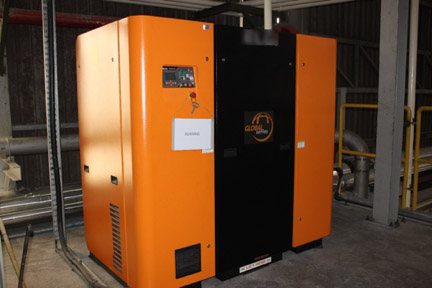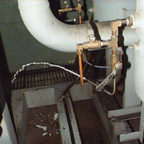
The development of the variable speed drive screw compressors has had a large impact on the efficiency of compressed air systems worldwide. If properly applied, one or more variable speed controlled compressors installed in a system will save energy and may even help better control system pressure.
Typical fixed speed compressors always run their main drive motors at full speed. If left to run at full output, an uncontrolled compressor would produce too much air for system demand, causing the pressure to rise to unacceptable levels. To prevent this, fixed speed compressors are capacity controlled using a few different strategies, so that the compressed air flow they produce matches the system demand. When both are matched, the system pressure remains constant.
The basic methods of part-load control for screw compressors are start/stop, modulation, load/unload, and variable capacity control. With the exception of start/stop—which can only be implemented on small compressors or in systems with multiple compressors—all of these methods have limited power turn-down capabilities … that is, the power will not reduce proportionally with the reduction in flow.
For example, a compressor that is producing 40% flow while running in modulation will still be consuming over 80% of its full load power, reducing its efficiency by more than half. Similarly, a lubricated screw compressor running in load/unload mode, with small storage receiver capacity at the same flow, would consume perhaps 75% of full load power. Use of a variable speed compressor in these cases could save between 30% and 50%.
Variable speed control of screw compressors, usually accomplished with variable frequency drives, gives an almost directly proportional reduction in power with flow reduction, if correctly applied.
Variable speed control of a compressor is most effective in systems with a wide variation in flows and with a small number of operating compressors. In systems with constant flow or with four or more running compressors, the variable speed control will be less effective. For systems with more than four compressors, the coordination of fixed speed compressor using sequencing compressor controls is often an economical solution.
Some other things to consider:
- It is best to purchase a variable speed compressor with the drive integrated rather than trying to retrofit a drive, which is fraught with technical problems.
- In multiple compressor systems, the size of the variable speed compressor is important, it typically needs to be equal to or larger than the largest base compressor with which it must work.
- Variable compressors are more expensive than fixed speed compressors, but they can often pay for themselves in less than three years, especially where power prices are high.
- Operation of variable speed compressors at full load is usually less efficient than running a similar sized fixed speed compressor.
- Long term operation near minimum speed with an oversized variable speed compressor should be avoided.
- Variable speed compressors of different makes and models have different energy curves, always check the Compressed Air and Gas Institute (CAGI) standard data sheets to compare before you purchase.
- Variable speed compressors are not suitable for every location. High levels of dust, excessive heat, and power fluctuations can cause failures that will quickly consume any energy savings if the compressor is misapplied.
- When operating with fixed speed compressors, the pressure settings coordination strategy of variable compressors is quite different than normal. Be sure to get assistance from your service provider to choose the correct scheme.




Operation of variable speed compressors at full load is usually less efficient than running a similar sized fixed speed compressor
This is incorrect
Hi Tony – I’m sure Ron would love a chance to discuss this with you – he can reply here or better yet, you can create an account at our forums and log your discussion there – he is one of our pneumatics moderators. https://forums.fluidpowerworld.com/.
Tony, I suspect you have problems with the words “usually less efficient”. That was my opinion too, until I started looking at the Compressed Air and Gas (CAGI) ratings of VSD compressors and comparing then to fixed speed units. Not all VSD compressors are less efficient than similar sized fixed speed units, for example, if you take a low cost single stage compressor and compare it with a premium brand unit, like a two stage unit, you might find the VSD beats the fixed speed even at full load. It always pays to check the specifications.
There is a big difference in the compressor system. For example, with oil-injected compressors, the specific power is rather the same on different speeds.
At oil-free rotaries, the internal leakages are much higher if the speed is going down. I believe it’s difficult to save energy at any oil-free compressor with a VSD.
Don’t forget that their drive-line consumes about 5% more to the VSD (converting frequency & higher losses in the engine),
On reciprocating compressors you can efficient regulate with the inlet valves, The slow running piston compressors are also about 15% more efficient at full load.
Why make it difficult if you can count on reliable and sustainable technology?